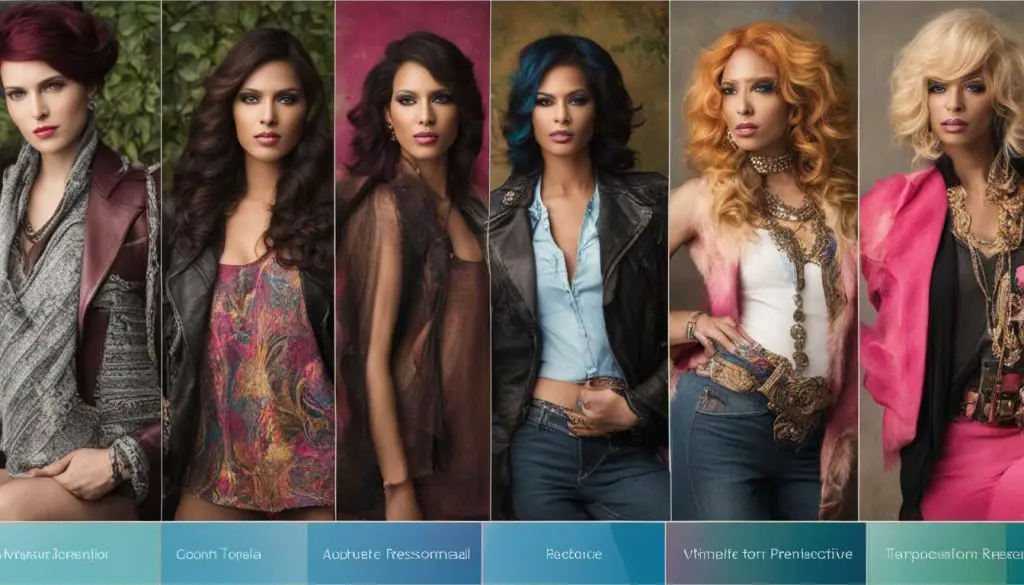Transgender and transsexual are related terms, but they have slightly different meanings that will be explored in this comprehensive guide. Understanding these terms is crucial for promoting inclusivity and respect for individuals whose gender identity differs from the sex they were assigned at birth.
Transgender is an umbrella term that encompasses various gender identities, including nonbinary, genderqueer, and genderfluid individuals. It refers to someone whose gender identity does not align with the sex they were assigned at birth. This section will delve into the meaning of being transgender and the experiences that come with it.
On the other hand, the term transsexual specifically refers to individuals who have taken steps to physically transition their bodies to match their gender identity. This can involve hormone therapy or surgical interventions. Please note that while some individuals still identify as transsexual, the term is considered outdated and offensive by many in the transgender community.
It is important to use the terminology preferred by each individual and to respect their chosen gender identity. This guide will also highlight the significance of understanding and supporting transgender individuals in order to create a more inclusive society.
To understand the nuances between transgender and transsexual, it is important to first define and explore each identity. Transgender is an umbrella term that encompasses individuals whose gender identity does not align with the sex they were assigned at birth. It is a broader term that includes various gender identities beyond the binary male/female concept. Some examples of transgender identities include nonbinary, genderqueer, or genderfluid. These individuals may experience a mismatch between their gender identity and the physical characteristics typically associated with their assigned sex at birth.
On the other hand, the term transsexual specifically refers to individuals who have taken steps to medically transition their bodies to align with their gender identity. This may involve hormone replacement therapy, surgical procedures, or both. It’s important to note that not all transgender individuals pursue medical intervention, and not all individuals who have undergone medical intervention identify as transsexual.
| Transgender | Transsexual |
|---|---|
| Encompasses a broader range of gender identities | Specifically refers to individuals who have pursued medical transition |
| Gender identity does not align with assigned sex at birth | Physical appearance is aligned with gender identity through medical interventions |
While some individuals still identify as transsexual, it is important to recognize that the term is considered outdated and offensive by many in the transgender community. Each individual’s preferred terminology should be respected and used. Using offensive language or making assumptions about someone’s gender identity can be hurtful and invalidating.
Educating ourselves and developing a deeper understanding of gender diversity is crucial in creating a society that supports and respects transgender individuals. By acknowledging and affirming people’s gender identities, we can help foster a more inclusive and accepting environment for all.

Being transgender means that an individual’s gender identity does not align with the sex they were assigned at birth, but what does that truly entail? Transgender is an umbrella term that encompasses a wide range of gender identities, including but not limited to nonbinary, genderqueer, and genderfluid. It is important to understand that gender identity is a deeply personal and internal experience, and it may not necessarily match the physical characteristics or societal expectations associated with one’s assigned sex.
Transgender individuals often go through a process of self-discovery and self-acceptance as they come to terms with their true gender identity. This journey can involve exploring and expressing their gender in ways that feel most authentic to them, whether it be through their appearance, pronouns, or social interactions. It is crucial to respect and affirm each person’s self-identified gender, using their preferred name and pronouns, as this fosters a sense of inclusivity and validates their identity.
Transgender is an umbrella term that encompasses a wide range of gender identities, including but not limited to nonbinary, genderqueer, and genderfluid.
It is important to note that being transgender is not a mental illness or a choice, but a natural variation of human diversity. Scientific research consistently supports the understanding that transgender identities are valid and should be respected. The American Psychological Association, for example, recognizes that gender identity is an integral part of a person’s overall identity and should be affirmed and supported. Providing education and promoting understanding about transgender experiences can help combat stigma, discrimination, and misinformation.
Transgender and transsexual terms
While the terms “transgender” and “transsexual” are related, they have slightly different meanings. Transgender is a broader term that encompasses various gender identities, while transsexual specifically refers to individuals who have undergone medical procedures, such as hormone therapy or surgery, to align their physical appearance with their gender identity. However, it is important to respect each individual’s preferred terminology and not make assumptions about their specific journey or medical choices.
| Term | Meaning |
|---|---|
| Transgender | An umbrella term for individuals whose gender identity differs from the sex they were assigned at birth. |
| Transsexual | Refers to individuals who have undergone medical procedures, such as hormones or surgery, to align their physical appearance with their gender identity. |

Respecting an individual’s self-identified gender and using appropriate terminology are essential in creating a safe and inclusive environment. By educating ourselves, challenging stereotypes, and fostering acceptance, we can contribute to a society that values and supports the diversity of transgender and transsexual individuals.
The Meaning of Transsexual
Unlike being transgender, being transsexual specifically refers to individuals who have undergone medical procedures to align their physical appearance with their gender identity. Transsexual individuals may opt for hormone therapy, surgery, or both to transition their bodies to match their gender identity. These medical interventions are often an important part of their journey towards living authentically and alleviating gender dysphoria.
It is essential to note that not all transgender individuals are transsexual. While some transgender individuals may pursue medical interventions, others may choose not to for various reasons. The decision to pursue medical interventions is deeply personal and should be respected and supported without judgment.
It is also important to recognize that the term “transsexual” is considered outdated and offensive by many within the transgender community. This term was historically used when medical professionals primarily focused on pathologizing transgender identities. However, contemporary understanding and acceptance of transgender individuals emphasize self-identification and respect for diverse gender identities. Therefore, it is best to use the preferred terminology of each individual and avoid assumptions or offensive language.

The Importance of Preferred Terminology
Respecting and using the preferred terminology of individuals who identify as transgender or transsexual is crucial for creating an inclusive and supportive environment. Understanding and acknowledging the importance of these terms is essential to show respect and validate a person’s gender identity.
Transgender is a broad term that encompasses a range of gender identities beyond the binary categories of male and female. This includes individuals whose gender identity differs from the sex they were assigned at birth, such as nonbinary, genderqueer, or genderfluid individuals. Using the term “transgender” to refer to these individuals recognizes and affirms their gender identity.
On the other hand, the term “transsexual” specifically refers to individuals who have undergone medical procedures, such as hormone therapy or surgery, to align their physical appearance with their gender identity. However, it’s important to note that not all transgender individuals identify as transsexual, and the term is considered outdated by many in the transgender community.
It is important to remember that gender identity is deeply personal, and individuals should be given the autonomy to define their own experiences. Using the incorrect terminology or making assumptions can be hurtful and invalidate a person’s identity. Taking the time to learn and understand the preferred terms of individuals is an act of validation and respect.
“We should always strive to create an environment where everyone feels comfortable and seen for who they truly are.” – LGBTQ+ Advocate
| Transgender | Transsexual |
|---|---|
| Encompasses a range of gender identities | Specifically refers to individuals who have undergone medical procedures |
| Includes nonbinary, genderqueer, or genderfluid individuals | May involve hormone therapy or surgery |
| Recognizes and affirms gender identity | Considered outdated by many |
Respecting and using the preferred terminology of individuals who identify as transgender or transsexual is an important step towards creating a more inclusive society. By understanding and using the correct terminology, we can foster a welcoming environment that celebrates and supports gender diversity.

By deepening our understanding of the differences between transgender and transsexual, we can better support and respect individuals who identify with these identities. Transgender is a broad term that encompasses various gender identities, such as nonbinary, genderqueer, or genderfluid. It refers to individuals whose gender identity differs from the sex they were assigned at birth. This identity is not dependent on any medical procedures or treatments.
On the other hand, transsexual specifically refers to individuals who have undergone medical procedures, such as hormone therapy or surgery, to align their physical appearance with their gender identity. However, it is important to note that while some individuals may still identify as transsexual, the term is considered outdated and offensive by many in the transgender community.
Supporting and respecting transgender individuals starts with using the terminology they prefer. It is essential to avoid making assumptions about someone’s gender identity and to use inclusive language. Education and understanding about gender diversity play a significant role in creating a supportive environment. By educating ourselves about these identities, we can challenge stereotypes and misconceptions, fostering a more inclusive society.

| Key Points: |
|---|
| Transgender is an umbrella term that includes various gender identities. |
| Transsexual refers to individuals who have undergone medical procedures to align their physical appearance with their gender identity. |
| Using preferred terminology and avoiding offensive language is crucial. |
| Educating ourselves about gender diversity fosters a more inclusive society. |
By embracing diversity and respecting individual identities, we can create a world where transgender and transsexual individuals feel accepted and valued. Let’s continue to educate ourselves, challenge our own biases, and support the transgender community on their journey towards self-acceptance and equality.
Conclusion
In conclusion, while transgender and transsexual are related terms, they have distinct meanings that should be understood and respected in order to create an inclusive society for all individuals. Transgender is an umbrella term that encompasses a range of gender identities beyond the binary of male and female. It refers to individuals whose gender identity differs from the sex they were assigned at birth. This can include nonbinary, genderqueer, or genderfluid identities, among others.
On the other hand, transsexual specifically pertains to individuals who have taken steps to align their physical appearance with their gender identity through medical procedures such as hormone therapy or surgery. However, it is important to note that the term “transsexual” is considered outdated and offensive by many in the transgender community. Each individual should be referred to using the term they prefer and should not be subjected to assumptions or offensive language.
Creating an inclusive society requires education and understanding about gender diversity. It is crucial to respect and support transgender individuals by using preferred terminology and avoiding offensive language. By embracing and accepting the diversity of gender identities, we can foster a society where everyone feels valued and respected for who they truly are.
FAQ
Are transgender and transsexual the same?
While related, transgender and transsexual have slightly different meanings. Transgender is an umbrella term that describes individuals whose gender identity differs from the sex they were assigned at birth. Transsexual specifically refers to individuals who have undergone medical procedures to align their physical appearance with their gender identity.
What is the meaning of transgender?
Being transgender means having a gender identity that differs from the sex assigned at birth. It is a broader term that includes various gender identities, such as nonbinary, genderqueer, or genderfluid.
What is the meaning of transsexual?
Transsexual refers to individuals who have undergone medical procedures, such as hormones or surgery, to align their physical appearance with their gender identity. However, this term is considered outdated and offensive by many in the transgender community.
Why is preferred terminology important?
It’s important to use the term preferred by each individual and to avoid using offensive language or making assumptions about someone’s gender identity. Using preferred terminology helps create a respectful and inclusive environment for transgender individuals.
How can we support and respect transgender individuals?
Education and understanding about gender diversity are crucial for supporting and respecting transgender individuals. By promoting awareness, challenging stereotypes, and using preferred terminology, we can create a more inclusive and accepting society.